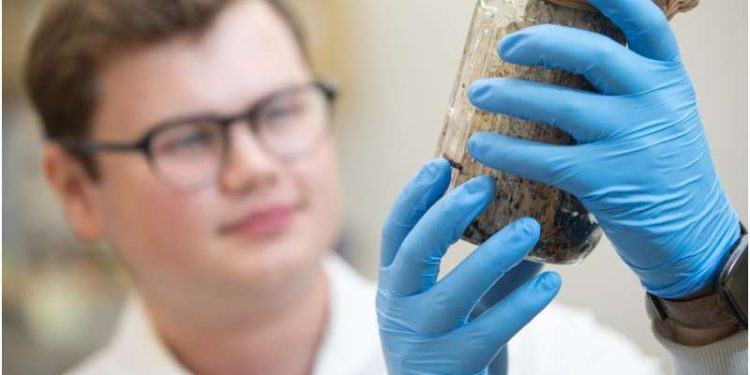
Joshua Carlson, a graduate of the University of Cincinnati, holds a container of non -infected kisses, the insects responsible for the transmission of the parasite responsible for Chagas disease. He was the main author of a study examining the targets to disturb the life cycle of the parasite. Credit: Andrew Higley
Chagas disease is often called silent killer because many people do not realize that they have it until the complications of infection kill them.
Researchers from the University of Cincinnati explore ways to interrupt the life cycle of the parasite behind the disease, offering the hope of developing a remedy.
The disease is propagated by parasites found in kisses insectswho suck people’s blood when they sleep. Insects generally bite the victims around their faces, which gives them their ironically sweet name. Bogues transmit the internal parasites In their poop, which infects the blood circulation of human hosts through bite wounds.
The study was published in the newspaper Mbio.
Chagas disease is in North and South America. Between 6 and 8 million people are infected, including 300,000 people living in the United States. But many realize that they are infected when they develop symptoms of decades later.
“The main problem with Chagas disease as a public health problem is that most people do not know that they are infected until the symptoms appear and that it is too late to treat them,” said assistant professor of the UC Noelia Lander.
In his molecular parasitology laboratory, Lander and his students study the complex life cycle of the parasite to find vulnerabilities to be exploited.

The biologist at the University of Cincinnati, Noelia Lander, studies Chagas’ disease in her molecular parasitology laboratory. Credit: Andrew Higley
The parasite is a tiny single cell body which undergoes four life cycle changes to survive and reproduce on its odyssey of the digestive system of an insect to the blood circulation of a human and a back. Along the way, he must be able to withstand spectacular differences in his environment such as acidity, temperature and availability of nutrients.
The parasite has lived on earth for millions of years – long before people.
“I know that the parasite is the enemy. But I am impressed by the mechanisms that the parasite must survive during his life cycle,” said Lander. “The objective is to find its weaknesses to fight against the disease.”
Joshua Carlson, a graduate of the UC, was the main author of the newspaper. The co-author and doctoral student UC Milad Ahmed said that the parasite hides in the cells in which he infects human tissueshelping him to escape both the immune system and drugs. Once the disease becomes chronic, treatments become much less effective, he said.
-

The graduate of the University of Cincinnati, Joshua Carlson, was the main author of a study examining objectives to disturb the life cycle of a parasite responsible for Chagas disease. Credit: Andrew Higley
-

The assistant professor of the University of Cincinnati, Noelia Lander, works in her laboratory of molecular parasitology. Credit: Andrew Higley
The researchers used genetic editing tools to manipulate the genes of the parasite. The objective was to identify the location and function of one of the proteins that help the small parasite to adapt, said the co-author of the study and the deputy professor of the UC, Miguel Chiurillo.
Lander said that the interruption of the parasitic life cycle is a promising target for future medical treatments.
“If the parasite cannot be transformed during his life cycleIt won’t survive, “she said.
More information:
Joshua Carlson et al, TCCARP3 Modules compartmentalized camp signals involved in osmoregulation, infection of mammal cells and colonization of the triatomine vector in the human pathogen Trypanosoma Cruzi, Mbio (2025). DOI: 10.1128 / Mbio.00994-25
Newspaper information:
Mbio
Supplied by
Cincinnati University
Quote: Scientists study the parasitic life cycle to fight Chagas’ deadly disease (2025, June 8) recovered on June 8, 2025 from https://phys.org/news/2025-06-biologists-lifecycle-deadly-paiSite.html
This document is subject to copyright. In addition to any fair program for private or research purposes, no part can be reproduced without written authorization. The content is provided only for information purposes.


